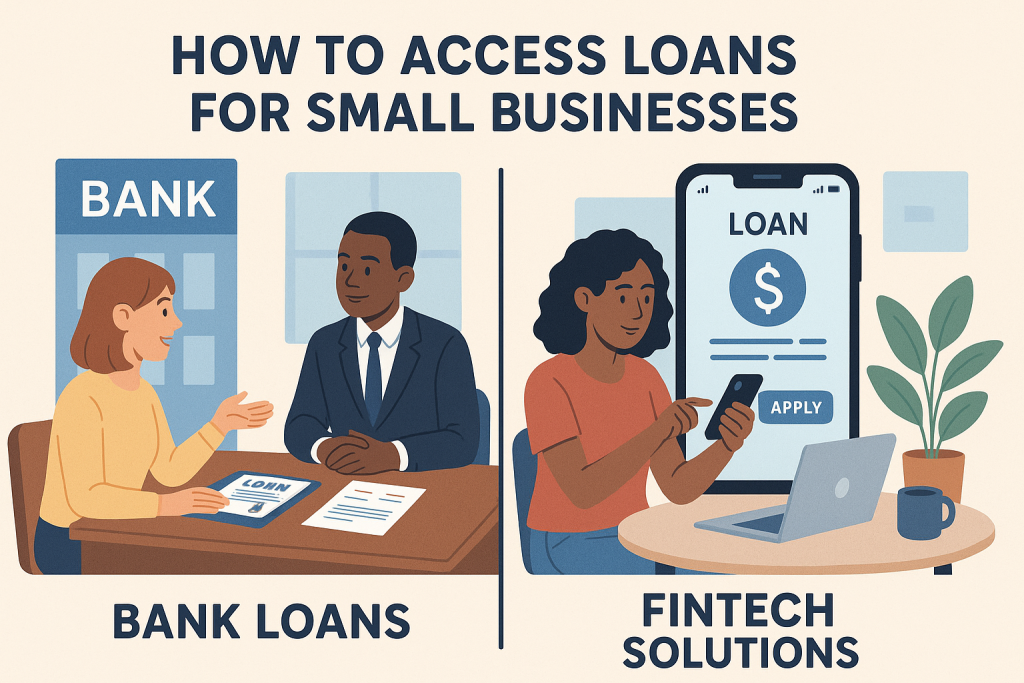
Running a small business is no easy feat — and when it comes to funding, the challenge can feel even greater. Whether you’re launching your startup, growing your operations, or navigating a cash flow crunch, accessing the right business financing can make all the difference.
In this article, we’ll explore how small and medium-sized enterprises (SMEs) can get the capital they need through bank loans and fintech lending platforms — comparing the pros, cons, and best-use scenarios for each. 💡
🏦 Traditional Business Loans: Are Banks Still the Best Option?
For decades, bank loans have been the go-to financing option for small businesses. They’re reliable, regulated, and often come with lower interest rates — but they’re not always easy to qualify for.
✅ Advantages of Bank Loans:
- Lower interest rates compared to alternative lenders.
- Structured repayment terms (ideal for long-term investments).
- Established credibility and consumer protections.
⚠️ Disadvantages:
- Slow approval process — applications can take weeks or months.
- Strict requirements, including credit history, collateral, and full financial statements.
- Limited flexibility in loan structures.
If your business is well-established, with strong revenue and a solid credit profile, traditional bank loans may offer the best cost-to-benefit ratio. But for many SMEs, the red tape and delay can be dealbreakers. 😓
💻 Fintech Lending: Fast, Flexible, and Digital 💸
Enter fintech lending — a fast-growing alternative that’s changing how small businesses access capital. From peer-to-peer platforms to online business lenders, fintech companies use technology to streamline the lending process and approve loans faster than ever before. ⚡
🚀 Benefits of Fintech Financing:
- Fast approval — many platforms offer decisions within 24-48 hours.
- Fully online application — no paperwork, no long lines.
- Flexible credit evaluations, often using real-time sales data, rather than traditional credit scores.
- Tailored loan options, such as revenue-based financing, invoice factoring, or microloans.
❗ Watch Out For:
- Higher interest rates — speed and accessibility often come at a price.
- Shorter repayment periods, which can impact cash flow.
- Less regulation, depending on the country and lender.
Popular fintech lenders include platforms like Kabbage, OnDeck, BlueVine, and regional players such as Konfío (LatAm), Funding Circle (UK), and Credibly (US). 🧠
🤔 Which Funding Option Is Right for You?
Choosing between a bank loan and a fintech lender depends on your business needs, financial health, and how fast you need the funds.
| Scenario | Best Option |
|---|---|
| You need cash fast | ✅ Fintech |
| You have strong financials & time to wait | ✅ Bank Loan |
| You want flexible repayment | ✅ Fintech |
| You’re making a long-term investment | ✅ Bank Loan |
| Your credit score is less than ideal | ✅ Fintech |
Pro tip: Always compare interest rates, fees, and repayment terms across multiple providers before committing. Using tools like a loan comparison calculator or APR estimator can help you make the most cost-effective decision. 📊
📈 High-Value Keywords to Watch (SEO + Monetization Tip)
If you’re running a content site or blog, targeting high-CPC keywords can increase your ad revenue significantly (think AdSense or affiliate income). Here are a few SEO-rich terms used in this post:
- Small business loans
- Business financing
- Working capital solutions
- Fintech lending platforms
- Alternative business funding
- Fast loans for SMEs
- Compare business loans
Adding these strategically — but naturally — throughout your content can boost both organic traffic and RPM. 🔍💰
🛠️ Tips to Improve Your Loan Approval Odds
Whether you’re applying through a bank or a fintech lender, these simple steps can improve your chances:
- Keep your financial records clean and updated 🧾
- Monitor your credit score regularly 📊
- Create a detailed business plan with revenue forecasts and use of funds 📈
- Show consistent income (especially for fintech platforms) 💵
- Apply only for what you need to avoid unnecessary debt 🚫
✅ Final Thoughts
Accessing loans for small businesses isn’t as daunting as it once was. With the rise of fintech and digital lending, entrepreneurs now have more options — and faster ones — than ever before.
Whether you go the traditional route with a bank loan, or opt for a modern fintech solution, the key is to be informed, strategic, and proactive. The right funding can fuel your growth, ease your cash flow, and take your business to the next level. 🌱
Just remember: it’s not just about getting the money — it’s about getting the right money, from the right source, at the right time.